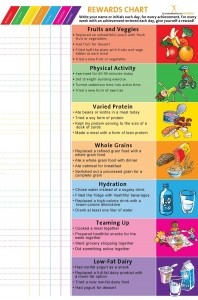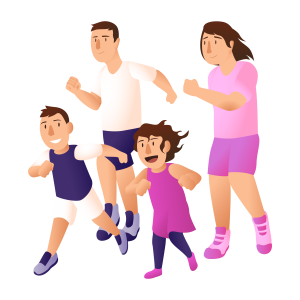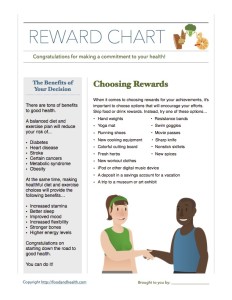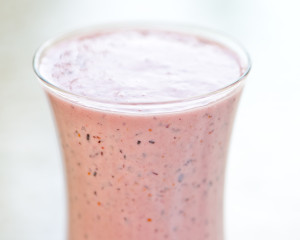One of the most popular tools in my nutrition educator’s bag of tricks is a good reward chart. It helps with motivation, makes it easier to celebrate important milestones, and adds a sense of fun to a new endeavor.
That’s why I created the Reward Chart poster. I wanted a resource that would help people focus on important health goals, and it has been flying off the shelves since its introduction to the store.
Today, because I love ya, I’m giving away the handout that comes with this poster, for free.
Yes, you read that right!
In order to further boost motivation, the Reward Chart poster comes with a simple handout about selecting rewards and the evaluating the impact of healthful choices. I’ve copied that information below and slipped in a free downloadable PDF of the handout too…
Choosing Rewards:
When it comes to choosing rewards for your achievements, it’s important to choose options that will encourage your efforts. Skip food or drink rewards. Instead, try one of these options…
 Hand weights
Hand weights- Resistance bands
- Yoga mat
- Swim goggles
- Running shoes
- Movie passes
- New cooking equipment
- Sharp knife
- Colorful cutting board
- Nonstick skillets
- Fresh herbs
- New spices
- New workout clothes
- iPod or other digital music device
- A deposit in a savings account for a vacation
- A trip to a museum or art exhibit
The Benefits of Your Decision:
There are tons of benefits to good health.
A balanced diet and exercise plan will reduce your risk of…
At the same time, making healthful diet and exercise choices will provide the following benefits…
- Increased stamina
- Better sleep
- Improved mood
- Increased flexibility
- Stronger bones
- Higher energy levels
Congratulations on starting down the road to good health.
You can do it!
And, as promised, here is the PDF handout that’s (usually) only available to people who already bought the Reward Chart poster. I hope you like it!
Last but not least, we have some other great resources in the Nutrition Education Store — they’re sure to give your clients a motivation boost!









 Earlier this week the U.S. Preventive Services Task Force released new recommendations regarding calcium supplements. They are recommending AGAINST daily supplementation with 400 IU or less of vitamin D3 and 1,000 mg of calcium carbonate for healthy older women, stating that it doesn’t work to prevent bone fractures in post-menopausal women. However, they say that the data is insignificant to make recommendations for larger doses of these supplements or for younger women or men. See the statement here:
Earlier this week the U.S. Preventive Services Task Force released new recommendations regarding calcium supplements. They are recommending AGAINST daily supplementation with 400 IU or less of vitamin D3 and 1,000 mg of calcium carbonate for healthy older women, stating that it doesn’t work to prevent bone fractures in post-menopausal women. However, they say that the data is insignificant to make recommendations for larger doses of these supplements or for younger women or men. See the statement here: